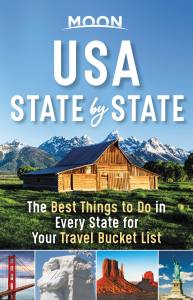Traveling to Mauna Loa via the Saddle Road
The Saddle Road is the other choice, besides near Hawai‘i Volcanoes National Park, for accessing Mauna Loa and its trails. The Mauna Loa Observatory Road turns south off the Saddle Road and zigs and zags up to the Mauna Loa NOAA Atmospheric Observatory at 11,140 feet, which you can see high on the hillside above as you progress along this road.

According to the signboard below this small complex, measurements are gathered here for carbon dioxide, carbon monoxide, methane, CFCs, ozone, solar radiation, atmospheric dust, stratospheric aerosols, and temperatures, among other items. Even a two-wheel-drive vehicle could handle this road without problems, but driving it would abrogate your rental car contract. Use a four-wheel-drive rental vehicle that is approved for this road. Although it could be done faster, give yourself an hour to take in the surroundings, check out the distant sights, and reach the end of the road. Use your vehicle lights, particularly if there are low clouds, and straddle the reflective white line that runs down the center of this single-lane road all the way up to the observatory, pulling over only to let vehicles from the other direction get by. The atmospheric observatory is not open to the public, but you can park in a small parking lot below it at the end of the pavement.
About two miles in from the turnoff is a rock formation at the side of the road that, at a certain angle, looks remarkably like Charles deGaulle, former president of France—and you don’t have to use your imagination much at all. As you continue, you get a fine, distant look at the observatories on top of Mauna Kea across the saddle, Pu‘u Huluhulu below at the turnoff, and the military reservation beyond to the west. About four miles in, at a turn in the road, there is a gravel road that heads over the horizon to the west, an abandoned attempt at a highway shortcut to Kailua-Kona.
Newsletter Signup
By clicking ‘Sign Up,’ I acknowledge that I have read and agree to Hachette Book Group’s Privacy Policy and Terms of Use
About eight miles up, at a point where there are a number of telephone and television transmitter towers, the road makes a big zag and heads almost in a straight-line shot, following power poles to the observatory. Notice the different colors of lava that the road crosses and the amount of vegetation on each type. The older brown lava has some grasses and small bushes growing from it, while the newer black lava is almost totally barren. There are large areas of red lava as well, and some of that has been used as road base and paving material. You will see several collapsed lava tubes near the road as you make your way up. Still farther on, areas of ropy pahoehoe lava stick up through newer ‘a‘a lava.
Around mile 15, new pavement has been laid so your ride gets smoother even as the road goes through a series of roller coaster waves as you approach the end of the road. Beyond the end of the pavement, an extremely rough Jeep track continues—best used as a hiking trail. This track zigzags up the mountainside, eventually ending near the crater rim after about seven miles. The Mauna Loa Observatory Trail leaves the gravel Jeep track several hundred yards beyond the end of the pavement and heads almost straight up the mountainside, crossing the Jeep trail several times. The Observatory Trail climbs 1,975 feet over 3.8 miles up the volcano’s north slope until it reaches the rim of the Moku‘aweoweo Caldera summit. From this point, the Mauna Loa summit cabin is 2.1 miles. It takes about 4-6 hours all together to hike from the Observatory trailhead to the Mauna Loa summit cabin. The hike back from the Mauna Loa summit cabin to the Mauna Loa Observatory trailhead is only about three hours, since you’re going downhill.

A helpful resource for this hike can be found at KinQuest. This site provides a guide with a mile-by-mile description of what you’ll see while you hike.
The Mauna Loa summit cabin is available to stay in for free but requires a permit from the Kilauea Visitor Center in Hawai‘i Volcanoes National Park; you can only get them the day before your hike. The Mauna Loa summit cabin has 12 bunks. Visitors are allowed a three-night maximum stay. Pit toilets are available at the cabin as well as drinking water. Don’t forget to treat the water. There’s no water available on the trail.
Mauna Loa is at a very high altitude, so wait at least 24 hours between scuba diving and ascending Mauna Loa in order to avoid getting the bends.
From the Pacific to the Atlantic, through prairies and bayous to snow-capped mountains, uncover the best of the US with Moon USA State by State.
Newsletter Signup
By clicking ‘Sign Up,’ I acknowledge that I have read and agree to Hachette Book Group’s Privacy Policy and Terms of Use
Pin it for Later



